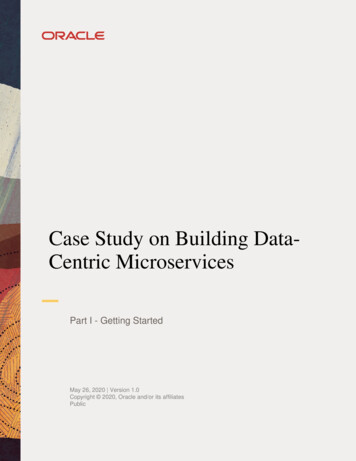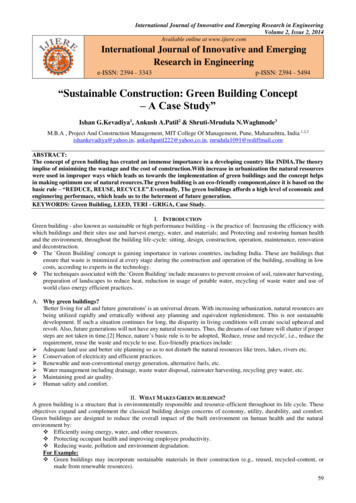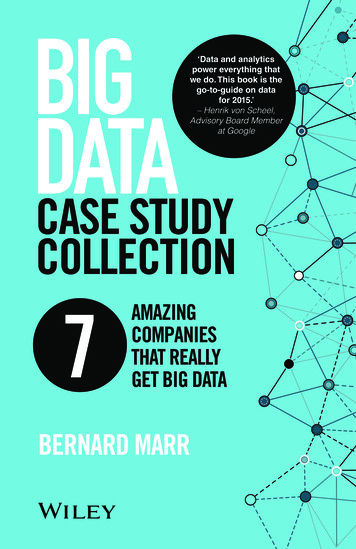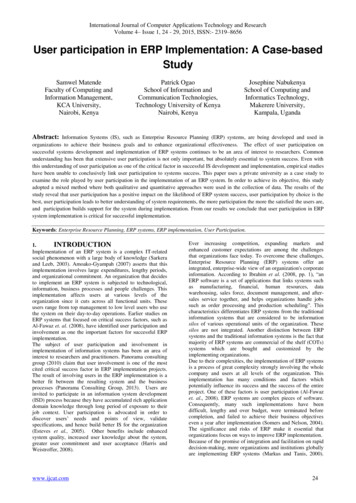
Transcription
Case Study on Building DataCentric MicroservicesPart I - Getting StartedMay 26, 2020 Version 1.0Copyright 2020, Oracle and/or its affiliatesPublic
DISCLAIMERThis document in any form, software or printed matter, contains proprietary information that is the exclusive property of Oracle. Your access toand use of this confidential material is subject to the terms and conditions of your Oracle software license and service agreement, which hasbeen executed and with which you agree to comply. This document and information contained herein may not be disclosed, copied, reproducedor distributed to anyone outside Oracle without prior written consent of Oracle. This document is not part of your license agreement nor can it beincorporated into any contractual agreement with Oracle or its subsidiaries or affiliates.This document is for informational purposes only and is intended solely to assist you in planning for the implementation and upgrade of theproduct features described. It is not a commitment to deliver any material, code, or functionality, and should not be relied upon in makingpurchasing decisions. The development, release, and timing of any features or functionality described in this document remains at the solediscretion of Oracle.Due to the nature of the product architecture, it may not be possible to safely include all features described in this document without riskingsignificant destabilization of the code.TABLE OF CONTENTSDISCLAIMERINTRODUCTIONARCHITECTURE OVERVIEWBefore You BeginOur Canonical ApplicationMicroservices Application ArchitecturePolyglot Persistence – Converged DatabasePersisting Events And State – Transactional Event QueuesTransactions Across Microservices – The Saga PatternData Distribution Across MicroservicesCASE STUDIESMicroservice SpecificationTest Environment SpecificationTest WorkloadJAVA CASE STUDYImplementationTest ResultsPYTHON CASE STUDYImplementationTest ResultsNODE.JS CASE STUDYImplementationTest ResultsCONCLUSION2DB TECHNICAL WHITE PAPER Case Study on Building Data-Centric Microservices Version 1.0Copyright 2020, Oracle and/or its affiliates
INTRODUCTIONFrom mom-and-pop brick and mortar to behemoth merchants, modern applications are based on Microservices architecture. Such anarchitecture brings undeniable benefits including: agile development, testing and deployment of independents services (DevOps, CI/CD), polyglotprogramming, polyglot persistence (data models), fine-grained scalability, higher fault tolerance, Cloud scale tracing, diagnosability, andapplication monitoring, and so on. However, such a Microservice architecture comes with inherent challenges including increasedcommunication, data consistency, managing transactions across services, and overall increased work. There are periodic debates about thegranularity of Microservices (micro or macro?) but the consensus is that the benefits outweigh the challenges. These challenges are usuallyaddressed at design level in splicing into a full application bounded domains of composable modular subservices. Modular principles have overallbenefits, which when implemented well, hold the keys to success with Microservices.The goal of this paper (first of a multi-part series) is to describe in detail how to build and deploy a data-centric application, and how the Cloudservices on the Oracle Cloud Infrastructure along with the Oracle Autonomous Database help simplify the key implementation challenges. Whilewe illustrate the key design principles on the Oracle Cloud, the underlying architecture and open interfaces can be implemented and deployed onpremises to get started.ARCHITECTURE OVERVIEWThis section discusses the requirements and challenges for a Microservices-based application including: polyglot persistence, persisting eventsand state, and data consistency across Microservices.Before You BeginWe highly recommend to understand: (i) the Twelve Factor App methodology; and (ii) the Cloud Native Computing Foundation frameworks andtechnologies as your Microservices platform is based on it. A simple overview of the twelve factor app is in the table below as these are goodpractices and we highlight some of these in the simplified best practices to build microservices with the Oracle Converged Database.3FACTORIMPLICATIONSCode baseTrack revisions in one codebase, with potentially many deploymentsDependenciesExplicitly declare and isolate dependenciesConfigStore config in the environmentBacking ServicesTreat backing services as attached resourcesBuild, release, runStrictly separate build and run stagesProcessesExecute the app as one or more stateless processesPort bindingExport services via port bindingConcurrencyScale out via the process modelDisposabilityMaximize robustness with fast startup and graceful shutdownDev/Prod ParityKeep development, staging, and production as similar as possibleLogsTreat logs as event streamsAdmin ProcessesRun admin/management tasks as one-off processesDB TECHNICAL WHITE PAPER Case Study on Building Data-Centric Microservices Version 1.0Copyright 2020, Oracle and/or its affiliates
A typical Microservice platform such as the Oracle Cloud Infrastructure (OCI) is made up of: an Image Registry (OCIR), Microservicedevelopment frameworks (such as Helidon), a Container (Docker or CRI-O), an Orchestrator (the OCI Kubernetes Engine a.k.a. OKE), a Servicebroker (Open Service Broker) for provisioning Cloud services, an API gateway, an Events service (OCI Events Service), a Service Mesh (such asIstio) and service graph visualization tools (such as Kiali), a telemetry and tracing framework (opentracing with Jaeger or equivalent), metrics andan analytic and alerting dashboard (Grafana or equivalent), storage services (OCI Object Store) and Oracle Converged Database with built-inTransactional Event Queues (TEQ) (such as the Autonomous Database or Exadata Cloud Service). Additional services like Oracle Functions,Oracle Machine Learning and Spark (OCI Dataflow), etc. can add real-time AI/ML capabilities to Microservices to make them intelligent.On the data side, the converged database supports Document (JSON), Spatial, Graph, and Relational data in a Container database (CDB) withone or more pluggable databases (PDB). This paradigm nicely allows for deploying SaaS services with multi-tenancy and microservices with dataisolation to separate PDBs when needed.Our Canonical ApplicationThis data-centric microservices application performs a transaction -- i.e., booking a mobile food order (e.g. appetizer, main course, dessert) fromone or many restaurants, wherein an order may fail if an item is not available in inventory, or delivery person is not available to deliver to thedestination. The Oracle Learning Library has a set of Hands-on-Labs that provides a self-service walkthrough of creating a Microservicesdeployment on the Oracle Cloud.As pictured hereafter, each service:Performs a specific task: book or reserve either a mobile food order, check for inventory, and delivery of the itemIs implemented using either Java, Python or Node.jsCommunicates with other services via Events using Oracle Transactional Event Queues (TEQ) transactional messagingAccesses both relational and NoSQL (JSON) data models in a dedicated Pluggable databaseThe key challenges include: adopting a polyglot persistence strategy, ensuring the atomicity of persisting data and events, ensuring dataconsistency, the handling of transactions across microservices and compensation logic when failures are encountered.4DB TECHNICAL WHITE PAPER Case Study on Building Data-Centric Microservices Version 1.0Copyright 2020, Oracle and/or its affiliates
Microservices Application ArchitecturePolyglot Persistence – Converged DatabaseData-driven applications use multiple data models including Relational, Document/JSON, Graph, Spatial, IoT, and Blockchain data.Your challenge consists in selecting either a specialized engine for each data model or a multi-model engine. Does your use case requireintegrating or querying across data models? For example, how would you persist a rich catalog containing text, images, graphs and documentsusing a single data model? Are you prepared for pulling data over here then injecting over there? Are you prepared for heterogenousadministration and patching mechanisms or looking for a unique/homogeneous administration mechanism across data models.The Oracle Converged Database is a multi-model engine with pluggable databases which simplifies the polyglot persistence challenge. Thisarchitecture brings the best of both worlds; it allows you to either specialize a pluggable database into a specific data model store or turn apluggable database into a general purpose multi-model store. In our canonical application, each Microservice uses a dedicated pluggabledatabase for storing both Relational and Document/JSON data. It also uses the in-built messaging and streaming layer (Transactional EventQueues) which provide transactional messaging to simplify application coding.Persisting Events And State – Transactional Event QueuesIn this application, we opt for event-driven communication between microservices often referred to as event sourcing. This is asynchronouscommunication with an event broker and an event store, which serves as the sole source of truth. Each microservice gets notified when an event,in which it has expressed interest via subscription, is produced. Upon completing its task, the service must persist changes to data and persist anevent for notifying other services. The challenge consists in persisting the state and the event, atomically, i.e. in the same local transaction (XAbeing an anti-pattern in microservices architecture). This asynchronous communication alleviates issues related to microservice environmentssuch as network outages and changes, transient availability of services themselves, back pressure, need for retry logic, etc. It also allows forloose coupling with other services which facilitates independent continuous development/test/deployment and fine-grained scaling.Several techniques or frameworks are used to address such challenges, notably: the Outbox pattern, using a table as a message queue, and theTransactional Event Queue.5DB TECHNICAL WHITE PAPER Case Study on Building Data-Centric Microservices Version 1.0Copyright 2020, Oracle and/or its affiliates
We pick Oracle Transactional Event Queues (TEQ) for the transactional messaging it provides, as it is built into the Oracle Database. TEQ’s APIsinclude JMS, Java, PL/SQL, C, and Kafka Java client. TEQ serves the purpose of an event store and event broker, where each microservicemaintains an incoming event queue to subscribe to other Microservices’ outgoing queues, and an outgoing queue to examine the incoming event,process it, and then respond. This is in contrast to using an API gateway, which also can be used in the context of Microservices, especially ifthere are very few microservices and the overhead of maintaining API changes is not overwhelming. Using an event store is more scalable sincemessages are asynchronous. TEQ delivers messages exactly once, by following transaction semantics in the database (not available for theKafka Java Client API), and by propagating messages/events between queues in separate databases. The producers and subscribers of eventscan send and consume messages within the exactly-once transaction semantics even in the presence of failures and retries. This is one of thekey advantages of the simplification of the messaging flows with TEQ in an Event-driven architecture.Transactions Across Microservices – The Saga PatternIn our canonical application, each service persists data in its dedicated local database. However, until the business transaction is completed orrolled back entirely, the data is not consistent at any given time but rather will eventually become consistent. As an example, the committedchanges to the available orders made by the order service of the current mobile ordering are not permanent as the order might be rolled back; thevalue of the available inventory read by another concurrent transaction is not consistent at the time of the reading as it will be changed when-ifthe current business transaction is rolled back. How do you ensure eventual consistency in long running transactions?In an asynchronous communication system, the two-phase commit protocol with distributed locking is a no-go. The Saga pattern helps ensure theconsistency of long-running business transactions. An application could use the orchestration Saga pattern with a Frontend service as thecoordinator -- as opposed to the choreography Saga where services communicate and coordinate among themselves without a coordinator.However, the Saga pattern comes with the following challenges/issues:1. It does not guarantee Isolation (as in A.C.I.D.); in the order booking example, the amount of available inventory is not the same uponrepeatable reads.2. High development/test costs of the compensating changes made by local transactions in the event of failure of the entire businesstransaction; the compensation code may amount for up to 80% of the microservices code which adds to huge code maintenanceoverhead.3. And there is additional complexity due to human interactionSaga Support could be entirely programmatic (DIY) or implemented via frameworks such as the Long Running Activity for Microprofile API, or viadatabase primitives. The Saga pattern for Microservices will be the subject of a future whitepaper in this series.6DB TECHNICAL WHITE PAPER Case Study on Building Data-Centric Microservices Version 1.0Copyright 2020, Oracle and/or its affiliates
Data Distribution Across MicroservicesOne of the best practices is to design microservices within bounded contexts, thereby guaranteeing data independence and avoiding transactionsacross microservices as much as possible. The additional benefits of data independence are: agility, as each service can be implemented by asmall team with no dependency on others; and the freedom for schema or database reorganization and placement. In principle, eachmicroservice comes with its dedicated database; however, such principle must not be taken to the letter. The following table discusses some ofthese possible ERATIONS/ISSUESANALYTICS/REPORTINGTable(s)/View(s) per microserviceSimplest initial maintenanceRole-based access controlViewsAvailability, maintenancerestrictions as all use samedatabaseSchema per microserviceSimple initial maintenanceAvailability, maintenancerestrictions as all use samedatabaseCross schema queries/viewsPDB per microserviceUltimate flexibility (PDBs can bedeployed together or separately,and this can be easily changedover time)Combine or separate based onavailability and maintenance needsCross PDB queries/views forPDBs in same CDBHighest isolationSeparate availability, maintenanceNon-Multitenant Database permicroserviceDatabase links for PDBs inseparate CDBsDatabase LinksExtra steps required to consolidateThe following figure depicts some of the many possible deployment or placement options. Three Oracle pluggable databases (PDBs) associatedwith three notional microservices: Order (O), Inventory (I), and Delivery (D). In the first example, all three PDBs are deployed within the sameContainer database (CDB) and would be maintained together with the same database release, patch and availability levels. In the secondexample, the PDBs are deployed each on its own CDB; each potentially with its own database release, patch level, and availability. The thirdexample depicts how PDB sharding can be used to provide additional scalability by sharding Delivery three ways, and sharding Inventory twoways, while Orders remains unsharded.7DB TECHNICAL WHITE PAPER Case Study on Building Data-Centric Microservices Version 1.0Copyright 2020, Oracle and/or its affiliates
CASE STUDIESTo compare and contrast microservice implementations, we defined a standard specification, test environment, and test harness. Thespecification is a subset of the Mobile Food Order application described earlier in this paper.Microservice SpecificationThe specification describes two microservices, Orders and Inventory, working together to place and fulfill orders. The microservices functionindependently with their own database schemas. The Orders microservice persists orders as JSON documents in a SODA collection. TheInventory microservice persists inventory information using a relational table. The services interact with each other through Oracle AQmessaging. The microservices respond to HTTP REST requests and to messages sent over AQ messaging.8DB TECHNICAL WHITE PAPER Case Study on Building Data-Centric Microservices Version 1.0Copyright 2020, Oracle and/or its affiliates
MESSAGE FLOWThe diagram below shows how an order is placed and how messages flow between the two microservices to check for and allocate inventory.1. Place Ordera. An external application calls the PUT /placeOrder interface on the Orders microservice with the order details.b. The order is inserted into the orders collection.c. A message is placed on the orderqueue queue.d. The insertion of the order and enqueuing of the message are committed to the database as a single transaction.2. Inventory Checka. The Inventory microservice receives the message on the orderqueue queue.b. The inventory is checked and allocatedc. A message with the inventory details is sent on the inventoryqueue queue.d. The receipt of the message, allocation of inventory, and sending of the message are committed to the database as a singletransaction.3. Order Updatea. The Orders microservice receives the message on the inventoryqueue queueb. The order document is updated in the orders collection.c. The dequeuing of the message and update of the order document are committed to the database as a single transaction.4. At any time, the order status can be queried through the GET /showOrder interface on the Orders microservice.9DB TECHNICAL WHITE PAPER Case Study on Building Data-Centric Microservices Version 1.0Copyright 2020, Oracle and/or its affiliates
FUNCTIONALITYMICROSERVICEOPERATIONOrdersPUT /placeOrderSPECIFICATIONInsert order (JSON) into the “orders” collection using the SODAinterfacePost a message to the “orderqueue” using the AQ interfaceCommitReturn the order (JSON)GET /showOrderRetrieve the order by orderid from the “orders” collection usingthe SODA interfaceReturn the order (JSON)Inventory Queue ConsumerRetrieve a message from the “inventoryqueue” using the AQinterfaceUpdate the order with the inventory statusCommitInventoryGET /inventoryQuery an inventory row from the inventory table by inventory idusing the relational SQL interfaceReturn the inventory information (JSON)Order Queue ConsumerRetrieve a message from the “orderqueue” using the AQ interfaceCheck and decrement the inventory in the inventory table usingthe relational SQL interfacePost a message to the “inventoryqueue” with the inventory statususing the AQ interfaceCommit10DB TECHNICAL WHITE PAPER Case Study on Building Data-Centric Microservices Version 1.0Copyright 2020, Oracle and/or its affiliates
MESSAGE FORMATQUEUEOPERATIONJSON FORMAT (BY EXAMPLE)orderqueuePUT /placeOrder{"orderid": “000012”,"itemid": “34”,"deliverylocation": “London”,"status": “pending” }inventoryqueueOrder Queue Consumer{“orderid”: “000012”,“action”: "inventoryexists",“inventorylocation”: “New York”}MICROSERVICE CONFIGURATIONPARAMETERFUNCTIONDB CONNECT STRINGDatabase TNS connect string.DB USERDatabase username.DB PASSWORDDatabase login password. Could be different on each database deployment and may vary overtime.DB CONNECTION COUNTNumber of database connections in the connection pool for each worker process.WORKERSOptional. Number of worker processes to be deployed per container.HTTP THREADSOptional. Number of HTTP threads to be deployed per worker process.DEBUG MODE1 – enable debugging, 0 – disable debugging. Used when testing and debugging theapplication.AQ CONSUMER THREADSNumber of threads consuming AQ messages.QUEUE OWNERDatabase schema that owns the database queues.DATABASE ACCESSThe microservices are implemented with connection pooling with Oracle FAN enabled.11DB TECHNICAL WHITE PAPER Case Study on Building Data-Centric Microservices Version 1.0Copyright 2020, Oracle and/or its affiliates
DATABASE SCHEMASSCHEMADEFINITIONl metadata : '{orders"keyColumn":{"assignmentMethod": "CLIENT", "name": "ORDERID", "sqlType":"VARCHAR2"}}';collection : DBMS SODA.create collection('orders', l metadata);inventorycreate table inventory (inventoryid varchar(16) primary key,inventorylocation varchar(32),inventorycount integer);insert into inventory values('24','New York', 10000);insert into inventory values('30','New York', 10000);insert into inventory values('31','New York', 10000);insert into inventory values('32','New York', 10000);insert into inventory values('33','New York', 0);insert into inventory values('34','New York', 0);The Orders microservice is given:Login access to the ORDERS schema containing the SODA “orders” collection.Enqueue access to the “orderqueue” and dequeue access to the “inventoryqueue” in the AQ schema.The Inventory microservice is given:Login access to the INVENTORY schema containing the inventory table.Enqueue access to the “inventoryqueue” and dequeue access to the “orderqueue” in the AQ schema.The fine grained security roles and privileges that are available with Oracle are useful for controlling the behavior of Microservices.12DB TECHNICAL WHITE PAPER Case Study on Building Data-Centric Microservices Version 1.0Copyright 2020, Oracle and/or its affiliates
Test Environment SpecificationDATABASE DEPLOYMENTThe ORDERS and INVENTORY schemas deployed on separate pluggable databases (PDBs) within the same container database (CDB).All case studies shared the same two node RAC release 19.6 database deployed on Oracle Cloud Infrastructure.Authentication was by username and password.The database connection string had the following structure:(DESCRIPTION (CONNECT TIMEOUT 5)(TRANSPORT CONNECT TIMEOUT 3)(RETRY COUNT 3)(RETRY DELAY 3) (ADDRESS LIST (LOAD BALANCE on)(ADDRESS (PROTOCOL TCP)(HOST SCAN ADDRESS )(PORT 1521)))(CONNECT DATA (SERVICE NAME DATABASE SERVICE NAME )))Access to the database was via a database service. The database service was created as follows:srvctl add service -db DB NAME -service SERVICE NAME -preferred "DBRAC1,DBRAC2" -pdb PDB NAME notification TRUEAQ CONFIGURATIONEach PDB contains an AQ schema with orders and inventory queues. Messages propagated between the queues in the schemas in eachPDBs. The following table details the queue and propagation configuration:SCHEMADEFINITIONAQ (Orders PDB)DBMS AQADM.CREATE QUEUE TABLE (queue table 'ORDERQUEUE',queue payload type 'RAW',multiple consumers true);DBMS AQADM.CREATE QUEUE (13queue name 'ORDERQUEUE',queue table 'ORDERQUEUE');DB TECHNICAL WHITE PAPER Case Study on Building Data-Centric Microservices Version 1.0Copyright 2020, Oracle and/or its affiliates
DBMS AQADM.grant queue privilege (privilege 'ENQUEUE',queue name 'ORDERQUEUE',grantee 'orders',grant option FALSE);DBMS AQADM.START QUEUE (queue name 'ORDERQUEUE');DBMS AQADM.CREATE QUEUE TABLE (queue table 'INVENTORYQUEUE',queue payload type 'RAW');DBMS AQADM.CREATE QUEUE (queue name 'INVENTORYQUEUE',queue table 'INVENTORYQUEUE');DBMS AQADM.grant queue privilege (privilege 'DEQUEUE',queue name 'INVENTORYQUEUE',grantee 'orders',grant option FALSE);DBMS AQADM.START QUEUE (queue name 'INVENTORYQUEUE');create database link INVENTORY. GLOBAL NAME connect to aq identified by" PASSWORD " using 'INVENTORY';DBMS AQADM.add subscriber(queue name 'aq.ORDERQUEUE',subscriber sys.aq agent(null,'aq.ORDERQUEUE@INVENTORY. GLOBAL NAME ',0),queue to queue true);dbms aqadm.schedule propagation(queue name 'aq.ORDERQUEUE',destination queue 'aq.ORDERQUEUE',destination14 'INVENTORY. GLOBAL NAME 'DB TECHNICAL WHITE PAPER Case Study on Building Data-Centric Microservices Version 1.0Copyright 2020, Oracle and/or its affiliates
AQ (inventory PDB),start time sysdate --immediately,duration null--until stopped,latency 0);--No gap before propagatingDBMS AQADM.CREATE QUEUE TABLE (queue table 'ORDERQUEUE',queue payload type 'RAW');DBMS AQADM.CREATE QUEUE (queue name 'ORDERQUEUE',queue table 'ORDERQUEUE');DBMS AQADM.grant queue privilege (privilege 'DEQUEUE',queue name 'ORDERQUEUE',grantee 'inventory',grant option FALSE);DBMS AQADM.START QUEUE (queue name 'ORDERQUEUE');DBMS AQADM.CREATE QUEUE TABLE (queue table 'INVENTORYQUEUE',queue payload type 'RAW',multiple consumers true);DBMS AQADM.CREATE QUEUE (queue name 'INVENTORYQUEUE',queue table 'INVENTORYQUEUE');DBMS AQADM.grant queue privilege (privilege 'ENQUEUE',queue name 'INVENTORYQUEUE',grantee 'inventory',grant option FALSE);DBMS AQADM.START QUEUE (queue name15 'INVENTORYQUEUE');DB TECHNICAL WHITE PAPER Case Study on Building Data-Centric Microservices Version 1.0Copyright 2020, Oracle and/or its affiliates
create database link ORDERS. GLOBAL NAME connect to aq identified by" PASSWORD " using 'ORDERS';DBMS AQADM.add subscriber(queue name ' aq.INVENTORYQUEUE',subscriber sys.aq agent(null,' {LANG} aq.INVENTORYQUEUE@ GLOBAL NAME ',0),queue to queue true);END;dbms aqadm.schedule propagation(queue name 'aq.INVENTORYQUEUE',destination queue 'aq.INVENTORYQUEUE',destination 'ORDERS. GLOBAL NAME ',start time sysdate --immediately,duration null--until stopped,latency 0);--No gap before propagatingMICROSERVICE DEPLOYMENTWe containerized each of the microservices using Docker and deployed each with two replicas on Oracle Container Engine for Kubernetesfronted by a load balancer.To deploy each of the microservices, we used YAML definition files similar to the following example from the Python implementation of theinventory microservice:apiVersion: apps/v1kind: Deploymentmetadata:name: python-inventorylabels:name: python-inventoryspec:replicas: 2selector:matchLabels:name: python-inventorytemplate:metadata:name: python-inventorylabels:name: python-inventoryspec:containers:16DB TECHNICAL WHITE PAPER Case Study on Building Data-Centric Microservices Version 1.0Copyright 2020, Oracle and/or its affiliates
- name: python-inventoryimage: tory:v12[c1]ports:- containerPort: 8080resources:requests:memory: 256Milimits:memory: 512Mienv:- name: DB CONNECT STRINGvalue: " DB CONNECT STRING "- name: DB USERvalue: "python inventory"- name: DB PASSWORDvalue: " DB PASSWORD "- name: DB CONNECTION COUNTvalue: "5"- name: WORKERSvalue: "1"- name: HTTP THREADSvalue: "16"- name: PORTvalue: "8080"- name: DEBUG MODEvalue: "1"- name: AQ CONSUMER THREADSvalue: "1"- name: QUEUE OWNERvalue: "PYTHON AQ"readinessProbe:exec:command:- cat- /tmp/readyinitialDelaySeconds: 0periodSeconds: 1timeoutSeconds: 1successThreshold: 117DB TECHNICAL WHITE PAPER Case Study on Building Data-Centric Microservices Version 1.0Copyright 2020, Oracle and/or its affiliates
failureThreshold: 1imagePullSecrets:- name: SECRET Microservice deployment on Kubernetes used the following command:kubectl create -f app.yamlThe following is an example from the Python inventory microservice of the YAML definition for the load balancer:apiVersion: v1kind: Servicemetadata:name: python-inventory-svcspec:type: LoadBalancerports:- port: 8080protocol: TCPtargetPort: 8080selector:name: python-inventoryLoad balancer deployment on Kubernetes used the following command:kubectl create -f lb.yamlTest WorkloadArtillery enabled us to drive a test workload. We monitored and collected the output from the test runs.TEST DATA GENERATIONThe following Python program generated 10 separate CSV test data files which drove workload for the tests:import csvimport randomitemids ["30","31","32","33","34"]num files 10for f in range(1, num files 1):with open('order%d.csv' % f, 'w') as myfile:wr csv.writer(myfile, quoting csv.QUOTE ALL)for i in range( f, 200001, num files):wr.writerow(["%06d" % (i), random.choice(itemids)])The following bash script shuffled (randomized) the data:18DB TECHNICAL WHITE PAPER Case Study on Building Data-Centric Microservices Version 1.0Copyright 2020, Oracle and/or its affiliates
for ((i 1 ; i 10 ; i ));doexport CSV FILE order {i}.csvshuf CSV FILE shuf CSV FILEdoneWORKLOADThe Artillery YAML definitions described in the below table drove the three HTTP REST interfaces at a rate of 60 requests per second:OPERATIONARTILLERY YAML DEFINITIONPUT /placeOrderconfig:environments:python kube:target: 'http://150.136.194.42:8080'python docker:target: 'http://0.0.0.0:8080'payload:path: "{{ processEnvironment.CSV FILE }}"order: "sequence"cast: falsefields:- "orderid"- "itemid"phases:- duration: 140arrivalRate:30name: "PUT"scenarios:- name: "PUT"weight: 12flow:- put:url: "/placeOrder?orderid {{ orderid }}&itemid {{ itemid }}&deliverylocation London"GET /showOrderconfig:environments:python kube:target: 'http://150.136.194.42:8080'python docker:19DB TECHNICAL WHITE PAPER Case Study on Building Data-Centric Microservices Version 1.0Copyright 2020, Oracle and/or its affiliates
target: 'http://0.0.0.0:8080'payload:path: "{{ processEnvironment.CSV FILE }}"order: "sequence"cast: falsefields:- "orderid"- "itemid"phases:- duration: 120arrivalRate:30name: "GET"scenarios:- name: "GET"weight: 10flow:- get:url: "/showOrder?orderid {{ orderid }}"GET /inventoryconfig:environments:python kube:target: 'http://150.136.0.242:8080'python docker:target: 'http://0.0.0.0:8081'payload:path: "inventory.csv"fields:- "inventoryid"phases:- duration: 120arrivalRate: 30name: "GET"scenarios:- name: "GET"weight: 10flow:- get:url: "/inventory/{{
process it, and then respond. This is in contrast to using an API gateway, which also can be used in the context of Microservices, especially if there are very few microservices and the overhead of maintaining API changes is not overwhelming. Using an event store is more scalable since messages are asynchronous.











